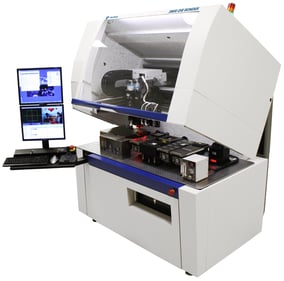There has been a recent upsurge in photonic packages used for fiber-optic communication. Fiber-optics has several distinct advantages over copper wire for higher speed communication over longer distances with less loss. Today, the communication speeds are over 100Gbps.

Most of the packages consist of Photodiodes (PD) and VCSELs connected by lenses to the fiber on one side and an ASIC device on the other. There are generally 2 or 4 pairs of PDs and VCSELs per package.
The interconnects from ASIC to PD and VCSEL are made using gold ball wire bonding and can be done with Palomar’s 8000i Wire Bonder with its low loop capabilities. The 8000i Wire Bonder is a fully automated thermosonic high-speed, ball-and-stitch wire bonder capable of ball bumping, stud bumping, wafer bumping, chip bumping, and customized looping profiles. As the assembly method of choice for first level interconnection, it is suitable for many aspects of packaging and component assembly, including: complex hybrids, MCMs and high-reliability devices.
The placement of the PDs and VCSELs is the most critical operation in these assemblies because both of these devices have optical apertures that must align with lenses. The lenses are generally molded plastics that have a specific pitch between the centers of each lens. The 3800 Die Bonder is used for the PD and VCSEL placement in conductive epoxy then the epoxy cures in a batch oven while maintaining the required placement accuracy of better than +/- 7 micron.
Conductive epoxies typically achieve their conductivity through small metal spheres/flakes. Silver is the predominate metal in more than approximately 95% of the epoxies available today. Some epoxies can contain 70% silver or higher. The major uses of conductive epoxies are to eliminate soldering on temperature sensitive devices, repairing PC boards, attach and connectivity of back-side metalized devices such as LEDs, gold bump interfaces, and many others. Benefits of conductive epoxies are: they are typically thermally conductive and they can even provide electromagnetic interference/radio frequency interference shielding.

The very small size of these devices also presents a challenge. Palomar’s engineers have assembled packages with PDs as small at 165 micron with the PDs and VCSELs sometimes coming in an array of 4 each. Then, we not only have to place the die with precise XY offset, but also Theta to make sure the arrays line up.
Once the PDs and VCSELs are placed and wire bonded, the lenses must be attached. This can also be accomplished with our 3800 Die Bonder using a UV-Cure option. A UV curable epoxy is dispensed and the lens is picked up. The “Look-Up” camera visualizes the lens centers and the “Look-Down” camera identifies the PD and VCSEL apertures. Software then calculates the placement offsets required to align the components. The UV light is activated while the lens is held in place assuring the highest accuracy. In some cases, additional epoxy is applied to the lens for added structural strength.
Palomar’s current 3800 Die Bonder customers have been completely satisfied with the placement accuracies of the 3800 Die Bonder (~5-7 micron 3 sigma final). For those who determine that higher accuracy is required, we offer the 6500 Die Bonder which has proven better than 1.5 micron 3 sigma.
Download these resources for more information:
| 8000i Data Sheet | 3800 Data Sheet | Automated Epoxy Die Attach e-book |
 |
 |
 |
-------
David Rasmussen
Assembly Services General Manager
Palomar Technologies, Inc.